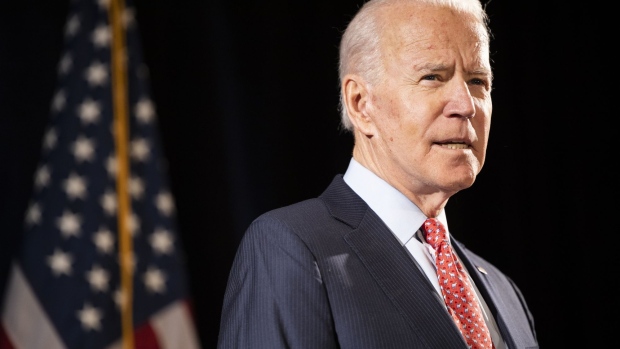, Bloomberg News

Joe Biden unveiled plans Tuesday to spend US$2 trillion galvanizing a clean energy economy, with ambitions to spur millions of union jobs building the wind turbines, sustainable homes and electric vehicles needed to rapidly throttle U.S. greenhouse gas emissions driving climate change.
“These investments are a win, win, win for our country,” Biden said in a speech in Wilmington, Delaware.
Biden’s clean energy blueprint, coming on top of separate initiatives seeking to pull the U.S. out of a pandemic-prompted recession, co-opts a hallmark of President Donald Trump’s re-election efforts by focusing on putting Americans to work rebuilding the nation’s infrastructure.
Biden’s plan also seeks to balance the desires of progressive Democrats who are demanding bold action to confront climate change while also protecting swing-state and manufacturing jobs.
“Even if we weren’t facing a pandemic and an economic crisis, we should be making these investments anyway,” he said.
Biden outlined a goal of “a carbon pollution-free power sector by 2035” -- a move that would require rapid acceleration in the deployment of renewable wind and solar power as well as electricity storage, while continuing to rely on emission-free nuclear power.
That rapid transition will enable the country to meet the threat of climate change while creating millions of jobs, according to campaign documents.
Biden has set a goal of spending US$2 trillion over four years on renewable energy infrastructure, getting cleaner cars on the road and creating zero-emission mass transit systems. The spending would also boost sustainable home building, clean energy innovation and conservation.
That pledge replaces an earlier initiative to dedicate US$1.7 trillion over 10 years to fighting climate change, and it adds to the US$3 trillion Biden committed last year to spend on infrastructure and clean energy, as well as the US$700 billion in new spending to spur manufacturing and innovation that he laid out last week.
A campaign official promised more details on how Biden would pay for his new proposals as well as the other pieces of his Build Back Better economic plan after the speech.
The official, who asked not to be identified prior to Biden’s announcement, said that tax increases on corporations and the wealthy that Biden has already proposed would be part of the plan.
The campaign has said those tax increases would raise US$4 trillion over a decade. Additional spending would likely be treated as one-time stimulus, meaning that Biden wouldn’t need to find a way to pay for the costs, further adding to the deficit.
Representative Steve Scalise, the House Republican whip from Louisiana, called Biden’s plan “Solyndra on steroids,” a reference to the solar manufacturer that received a US$535 million loan guarantee as part of the 2009 recovery package and later declared bankruptcy. Scalise predicted more such cases as a result of Biden’s plan, Scalise told reporters in a call Tuesday.
The Trump campaign also slammed the Biden plan, saying it would “devastate American families and businesses.”
Senior Biden campaign officials emphasized that his proposals cannot be easily undone by a successor, unlike Trump’s deregulatory agenda.
Washington state Governor Jay Inslee, who first charted the 2035 carbon-free power target Biden is now adopting, heralded the initiative in an emailed statement, saying it showed Biden is “serious about defeating climate change, and has a road map to become the climate president that America needs.”
Progressives, Unions
One challenge for Biden lies in convincing progressive voters that he hasn’t left them short even as he set aside some of the more ambitious moves called for in the Green New Deal championed by left-wing Democrats including Representative Alexandria Ocasio-Cortez.
Some arms of organized labor, key allies for Democrats, seemed to like the plan, while others could emerge as an obstacle. Biden’s emphasis on addressing climate change risks alienating blue-collar workers in Pennsylvania, Ohio and other swing states now producing natural gas and refining oil into gasoline.
The United Auto Workers welcomed the plan, calling it in an unsigned statement a “win-win” that “will ensure that the industry will thrive for decades to come with good paying union jobs.”
The Biden campaign says he would create 1 million new jobs in the American auto industry. Spending on transit would ensure that American cities with more than 100,000 residents would have access to zero-emission public transportation, built by union workers. Organized labor would also be employed upgrading 4 million buildings and weatherizing 2 million homes over the next four years.
Environmental Justice
The initiative also seeks to emphasize environmental justice, creating special divisions of the EPA and Justice Department dedicated to ensuring protection for front-line communities that are most exposed to the effects of pollution including criminal charges.
Gina McCarthy, head of the Environmental Protection Agency under President Barack Obama and now president of the National Resources Defense Council applauded the plan as “the most ambitious we have ever seen from any president in our nation’s history.”
Fracking
Environmentalists have pressured Biden to shut down hydraulic fracturing, the technique used to extract oil and gas from some 90 per cent of U.S. wells, but Biden has been cool to the idea, telling Pennsylvania’s WNEP-TV last week that “fracking is not going to be on the chopping block.”
Nevertheless, Biden has promised to curtail oil and gas development on federal lands and waters managed by the U.S. government, and a senior campaign official said Tuesday Biden is committed to no new fracking on federal lands.
No comments:
Post a Comment